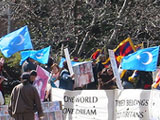Tibet Is Not Xinjiang
By Denis Burke for ISN
Tibet is an easy starting point for discussions of unrest in China as a result of its troubles being widely publicized. Tibet and Xinjiang are superficially similar, at best. Nonetheless, a valid and insightful comparison can be made on the basis of the targeted violence against Han Chinese settlers in both areas, pointedly between March 2008 in Tibet, and July 2009 in Xinjiang.
Tibet’s status within China has been ubiquitously controversial, even prior to its occupation by the PRC. Throughout the nearly 60 years since the Peoples Liberation Army crossed into Tibet, Tibet has had the attention of the international community, with sympathizers throughout Asia and the western world. Xinjiang, on the other hand, still sits in almost total obscurity. Indeed, Xinjiang was practically unheard of in much of the world prior to the emergence of the five central Asian ‘stans’ that have many cultural commonalities with Xinjiang.
Similarly, the Tibetan cause has advocates across the globe, while Xinjiang sees only sporadic support, which comes mainly from the Muslim world. A scarcely credible re-branding of the Dalai Lama as a feudal overlord, determined to split the motherland, has been central to Beijing’s public relations in regard to Tibet. The war on terror has served as a far more convenient and effective tool against the Uighurs. While the Dalai Lama is perceived as an advocate of non-violent resistance, Xinjiang’s lack of an identifiable leader makes it easy to portray as a hotbed of terrorism.
Tibetan aggression in the 2008 riots was quite invisible to many western reporters. Similarly, recent stories in the western press have tended to emphasize the oppression of Uighurs more than the hospitalization of hundreds of Han Chinese.
Comparing Tibet and Xinjiang tells us little about either region, though it can offer an insight into China’s minority policies. Economic tension underlies both Lhasa 2008 and Urumqi 2009: economic tension that ultimately found expression through ethnic violence. History abounds with comparable examples of marginalized, less educated, native populations that have violently turned on richer, ethnically diverse newcomers.
A prevailing attitude among Chinese bloggers is that money has poured into the development of these areas, as the government has done a lot to protect their language and customs, so the question remains: Why can’t these people be grateful?
Imagining that Tibetans or Uighurs are not interested in sharing eastern China’s prosperity would be short sighted, but as Joanne Smith Finley of Newcastle University recently external pagecommented to Reuterscall_made: "If Beijing gave them proper autonomy, stopped Han migration, and gave the people the language and religious rights that are guaranteed anyway in the Chinese constitution, they might well find that Uighurs would quite happily remain part of China," and Tibet’s government in exile explicitly says the same thing in their external pageMiddle Way Approachcall_made.
Beijing is no doubt concerned that concessions to one restive area will lead to increased demands from the others. As China’s economic and military power increase at a dizzying pace, the real similarity is that the failure of the government’s Tibet and Xinjiang policies will continue to undermine their soft power.

